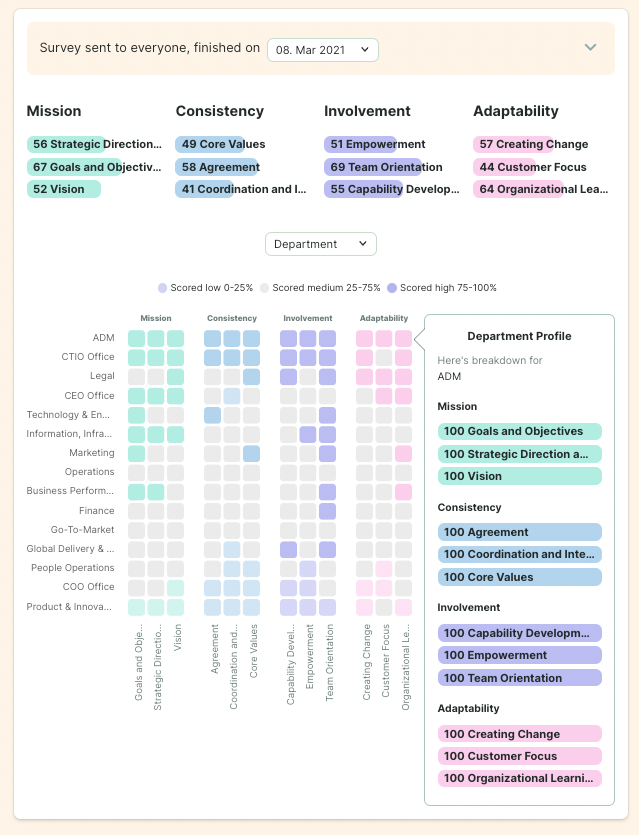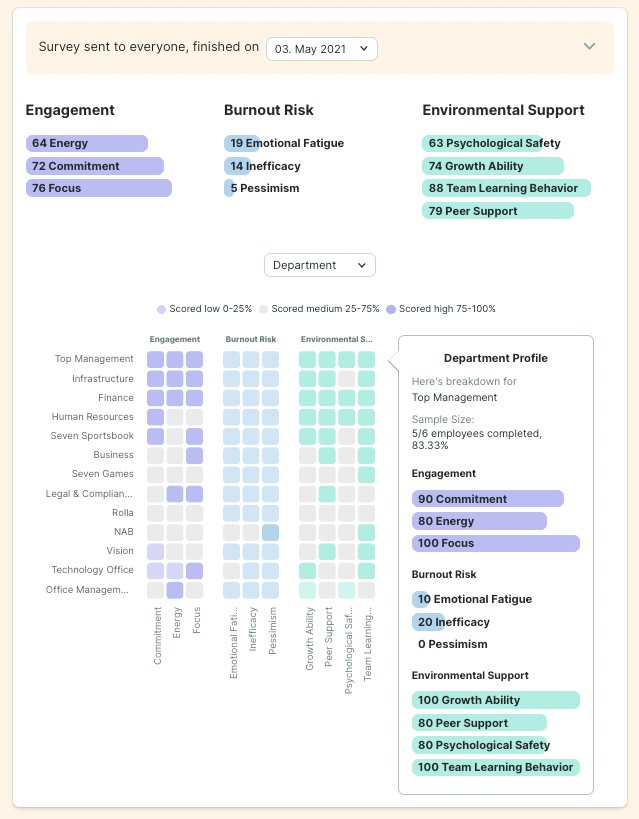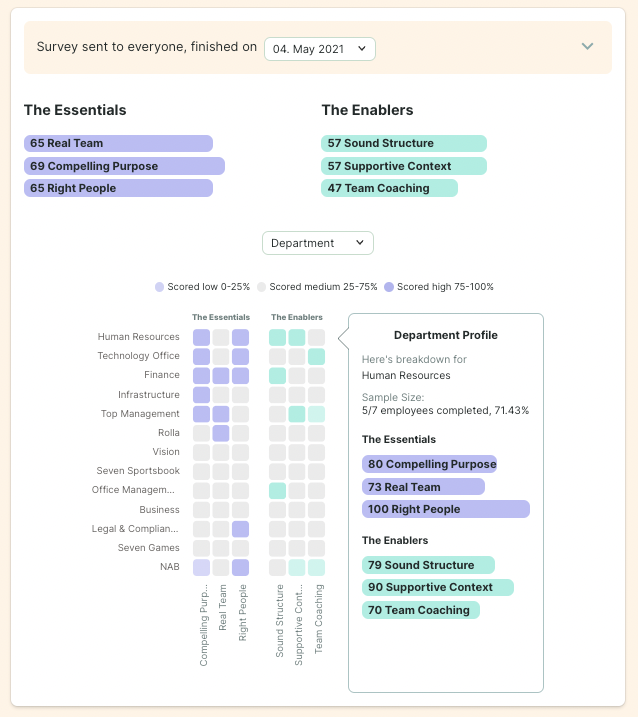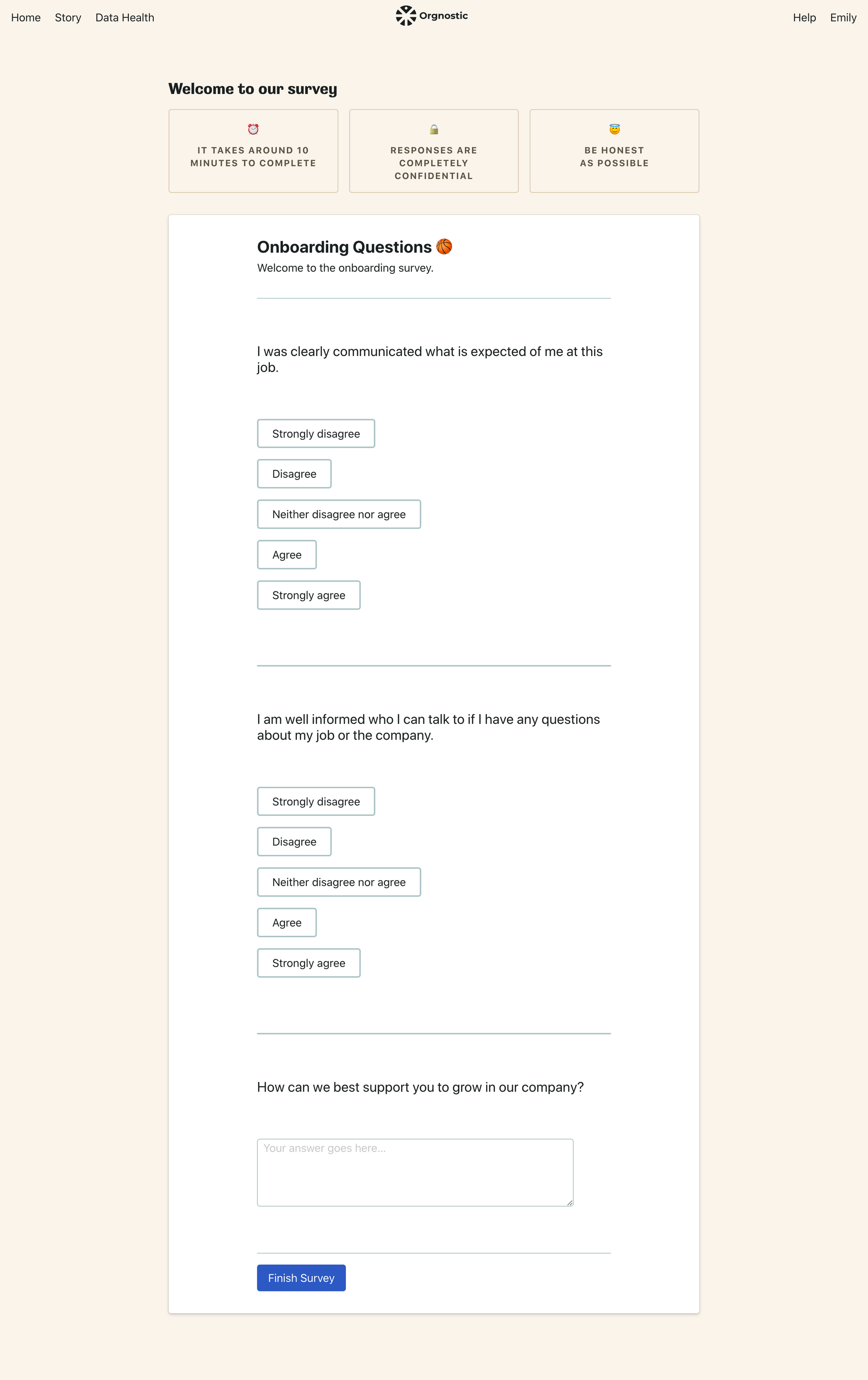Pulse surveys were all the rage in the not-so-distant past. Now, a new breed is here: Context-driven surveys. Come find out why you should use them.
The simple act of asking someone for feedback is a promise. A promise that they will be heard. A promise that their feedback will be weighed, considered, and acted upon. A promise that they matter.
A survey is a promise, and employees are no different than normal people when they are asked for feedback via surveys. What you say matters.
Employees want to be listened to. In the context of a recent pandemic and HR trends over the last few decades, companies have started to acknowledge this truth and have implemented ways to hear employees’ voices and check how they’re doing.
However, asking for employees’ feedback is not to be taken lightly: if managed the wrong way, it can backfire. For example, not following up or taking action about what employees say will result in more disappointment than if no questions were asked.
“You spoke; we listened; we changed” is a common refrain for the appropriate manner for companies to respond to employee feedback.
The most common tool for gathering employees’ feedback are surveys — (bi-)annual engagement surveys with many questions on different topics, or ‘pulse surveys’ — shorter, more frequent surveys.
The appeal of pulse surveys lies in their ability to quickly and easily check how the workforce is doing — just like taking a pulse. But do pulse surveys check enough boxes when it comes to taking action based on employee feedback?
In this post, we look at the shortcomings of HR pulse surveys — and why we must look for alternatives in context-driven surveys.
What is an employee pulse survey?
Pulse surveys are short, frequent check-ins that measure the same set of indicators over time. These surveys typically go out every week, month, or quarter and have around 10-20 same questions asked repeatedly, if done scientifically, to a representative sample of the organization.
For example, pulse surveys include questions and statements like:
- How proud are you to work for this company?
- To what extent do you agree with the statement — “I have seen positive changes taking place as a result of previous surveys”?
- Do you think that your work and contributions are valued by the company?
- I feel included by the people with whom I work
- Or even a “thumbs up” or “thumbs down” on how the employee is feeling
What are the disadvantages of using pulse surveys?
When doctors measure a person’s pulse, they know whether the person is OK or if there’s something wrong. But they don’t know much more than that — there’s little indication of what exactly the person is suffering from — only that something is seriously wrong if there are some irregularities there.
Employee pulse surveys have the same drawback: they can tell you if something’s wrong — for example, if engagement is going down — but they don’t tell you much else. They can tell you what, but they can’t tell you why.
There’s no way for employees to give you more context about their worries and what’s not working for them.
With pulse surveys, in an HR function, you are left to figure out the mystery of what causes a lower engagement or sentiment — and with no data to shed light on the root causes, it’s often a matter of speculation and brainstorming. So much for pulse surveys being a quick diagnostic tool…
Another issue with pulse surveys is their frequency — they’re short, as you can run them weekly, monthly, or quarterly. This means asking employees the same questions repeatedly — unless some sort of sampling strategy is used.
When you think about it from the employee’s perspective, it doesn’t sound like such a good idea anymore. Receiving the same set of questions over and over again, requiring time and effort to provide meaningful answers, gets tiring. We’ve even heard of organizations that force employees to take these types of surveys every day.
Survey fatigue is a real issue, not to mention the ethical concerns with survey coercion, and it impacts the quality of the data collected and employees’ morale. Employees will soon decide not to even open the pulse survey or will fill it out without giving it too much thought, just answering randomly.
Since the questions are not related to anything specific that happened since the last survey, they might legitimately wonder why you’re repeatedly asking the same questions. Are they seeing improvements based on their feedback? Is their voice being heard? Likely not.
If pulse surveys don’t work, what should you do instead?
Enter context-driven surveys.
These employee experience surveys consider the context — they ask employees for input about specific elements of their experience and workplace.
For example, employees can voice their feedback on how effective their team is or how fair the talent management practices are. By asking employees context-rich questions, they know what is assessed and can answer in meaningful and reliable ways. They are not left with doubt about the purpose and meaning behind the questions.
Another way to build context into your employee experience surveys is to link them to specific events — for example, when someone joins or leaves the organization.
These are special moments in an employee’s journey with the organization, and by assessing particular aspects related to them, you can gain insights that are tricky to get from regular, generic pulse surveys. In addition, the insights gleaned from these surveys can quantify critical touch points in an employee’s career.
Pulse surveys vs context-driven surveys
The distinction between pulse surveying and context-driven surveying is that context-driven surveys adjust the survey content to the context, based on the sets of variables that trigger that content.
Let’s say you notice a spike of unplanned leaves among a certain segment of employees.
For example, these are employees in leadership positions with 3-4 years of tenure. And on top of that, you know that unplanned leaves pattern changes are correlated with burnout risk.
So, in this context, you would send an employee wellbeing survey to this group of employees in order to capture what is going on and whether you, as an HR, can address the issue.
Meanwhile, a pulse survey would completely neglect the context.
Instead, it would send out a set of generic questions every three months. In most cases, the feedback would not be actionable — and so you would not be able to get meaningful insights that you could then use moving forward.
A pulse survey is a weather report, and a context-driven survey tells you why it might rain.
A similar would go for onboarding and offboarding. Onboarding and exit surveys are also context-driven employee experience surveys. They are triggered based on specific events and their content is tailored to the specific context and time in the employee’s lifecycle.
Context-driven surveys in practice
Lately, many organizations have become aware of how important their employees’ wellbeing is — not just from an ethical point of view but also for the business’s sustainability and performance.
Here’s how context-driven surveys help measure employee engagement, using the example of the Employee Wellbeing Survey.
The Employee Wellbeing Survey has 17 targeted questions about how your employees feel about engagement, burnout, and safety at work.
However, despite a seemingly overwhelming number of questions, this survey takes about 3 minutes. It is conceptualized on engagement-burnout theory measured by the Utrecht Work Engagement Scale, and Maslach’s Burnout Index and embellished with constructs such as Psychological Safety, popularized by the work of Dr. Amy Edmondson at Harvard. Thus, it provides a solid, validated tool to know how your employees feel.
The survey works by presenting a list of statements that describe different ways in which employees can feel about their job.
For each statement, they have to indicate how frequently they felt like that in the last month, from 1 (never) to 5 (always). Some statements are:
- I feel great about going to work in the morning.
- I haven’t accomplished much at all in this job.
- My teammates and I can talk about mistakes and ways to prevent and learn from them.
By using this type of survey, employees are asked relevant questions which make it clear to them how their feedback can help. They have clear expectations and an objective reference point when answering the survey items. Uncertainty and survey fatigue is reduced, as employees respond to different questions based on what you’re interested in measuring.
Context-driven surveys for engagement across the employee life cycle
Now that you know about context-driven employee surveys and their benefits, you might wonder where to start.
What specific things should you ask your employees about? And how can the science of surveys assist you in being the most effective in keeping your promises to employees?
Orgnostic can help with this. We have selected five science-backed surveys that measure the most relevant aspects of the employees’ experience which drive performance and engagement: culture, team dynamics, well-being, talent management practices, and the Employee Net Promoter Score Survey (e-NPS) as an overall indicator.
Culture Survey
The Culture Survey assesses the state of organizational dynamics that link with business performance. It is based on Denison’s Culture model and their Denison Organizational Culture Survey (DOCS) instrument, the most widely used and research validated diagnostic tool for establishing the link between organizational culture and company effectiveness.

Employee Wellbeing Survey
The Employee Well-being Survey assesses how your employees feel about engagement, burnout, and safety at work — especially relevant topics in today’s reality of post-pandemic living with a renewed focus on employee wellbeing.

Team Effectiveness Survey
The Team Effectiveness Survey assesses team dynamics that lead to excellent team performance. It is based on the Team Diagnostic Survey developed at Harvard by Drs Ruth Wageman, J. Richard Hackman, and Erin Lehman. By using this survey, you can improve team design practices and provide your front-line and top-level managers with a blueprint for team interventions.

Talent Management Survey
The Talent Management Survey quickly assesses vital qualitative features related to your talent management processes: rewards system fairness, performance accountability, and information flow. The Talent Management Survey is inspired by Dr Dave Ulrich’s work on the Leadership Capital Index and measurements designed to capture the value of talent management systems. The survey helps you fill in the qualitative gaps that complete the story of your employees’ lifecycles in, through, and out of your company.
Employee Net Promoter Score Survey
The Employee Net Promoter Score Survey, or e-NPS, is a two-question survey to assess how likely your employees are to recommend your company as a great place to work. Net Promoter Score, the basis of e-NPS, is based on a measurement used to evaluate customer loyalty (with scores ranging from +100 to -100).
The most crucial feature of e-NPS is that it is quick and straightforward to measure. It is easy to reference and compare, but you should use it along with other metrics to get a broader picture of your employee experience.
Additionally, you can also choose to use two trigger surveys related to someone’s Onboarding and Exit.
An onboarding-triggered survey assesses the new employee’s and their direct manager’s expectations, and a follow-up after the first three months can give you the first insights into the employee’s engagement. An exit-triggered survey can inform you about the reasons behind the decision, how you could have retained them, and the skill gap created.

How Orgnostic helps with Surveys
In today’s workplace, data is vital — it helps you understand your workforce, guides decisions, and adds credibility.
However, collecting data needs to be done correctly; otherwise, you risk compromising your employees’ availability to provide you with valuable insights.
Switching from pulse surveys which repeat the same generic questions over and over again, to context-driven surveys is the first step towards better employee surveys!
With Orgnostic People Analytics platform, you can get context-driven insights into your employee experience across the employee life cycle in a few simple steps:
- Register on the Orgnostic platform.
- Connect your ATS and HRIS data.
- Run one of the existing surveys — or build a custom one from scratch.
- Ta-da: Get results with the next steps and recommendations on what to improve across your organization.
Employee engagement is a dialogue. To have an engaged workforce, you need to tend to it. This means you need to listen to each employee, with different needs, career aspirations, and at different stages in the employee life cycle.
Running pulse surveys helps — but only to an extent. You might get the gist, but you will lack a wider context.
The context that would take into account each employee’s unique needs and allow you to keep the promise and create an environment where engagement comes as a result of a promise kept. And context-driven surveys are the first step towards building that environment.
Big thanks to Iulia Cioca and Cole Napper for sharing their experience and insights and writing this article. 🙌
